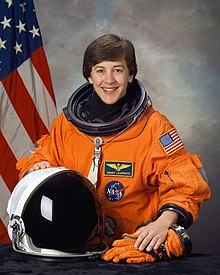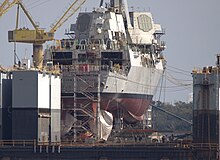William P. Lawrence
William "Bill" Porter Lawrence (born January 13, 1930 in Nashville , Tennessee , † December 2, 2005 in Crownsville , Maryland ) was an American Vice Admiral in the US Navy , who was the first naval aviator in the 1950s to test twice at the speed of sound flew after its launch on 28 June 1967 during the Vietnam war in captivity came and was only on March 4, 1973 dismissed it.
He later served as Superintendent of the US Naval Academy from 1978 to 1981 , Commander of the 3rd Fleet from 1981 to 1983 and, most recently, Chief of Naval Personnel between 1983 and his retirement in 1986 .
Life
Military training and the Vietnam War
Lawrence, whose father Robert Landy "Fatty" Lawrence was a well-known American football player for the Vanderbilt Commodores during his studies at Vanderbilt University from 1921 to 1924 , began his training at the US Naval Academy in Annapolis after school and entered it Graduated from the US Navy in 1951. First he stayed as a lieutenant at sea until September 1951 as an adjutant to the commandant at the US Naval Academy. He then completed pilot training as a naval aviator (US Naval Aviator) at the US Naval Test Pilot School on the Naval Air Station Patuxent River , which he completed in 1952. As a test pilot, he was the first naval aviator to fly twice at the speed of sound in the 1950s.
After further aviation training he was pilot of a carrier-based fighter - bomber of the type McDonnell F2H "Banshee" at Moffett Federal Airfield between March 1953 and October 1955 , where he was used at the beginning of this time from March to April 1953 as a pilot on the aircraft carrier USS Oriskany . After NASA began planning the Mercury program for named space travel, he took part in the selection tests there.
1967 Commander Lawrence as commander ( Commanding Officer ) of Strike Fighter Squadron 143 (VFA-143) on board the aircraft carrier USS Constellation transferred for use in the Vietnam War. For his services there he was awarded the Silver Star and the Distinguished Flying Cross . A few weeks later, on June 28, 1967, he was shot down with his twin- engine supersonic McDonnell F-4 fighter aircraft during a flight over Nam Định and was taken prisoner of war , which he held until his release on March 4, 1973 in Hỏa Lò prison , the so-called "Hanoi Hilton". There he was next to James Stockdale one of the most senior prisoners in the US Navy.
Upon his release, Lawrence was first awarded the Navy Distinguished Service Medal , the second highest award in the US Navy, for his services to fellow prisoners . Furthermore, instead of two other Silver Stars, he was awarded two gold stars for his first Silver Star as well as a Bronze Star to honor his services during his captivity.

Following Lawrence took his service in the US Navy again and, after his promotion to rear admiral in July 1974 commander of the US Pacific Fleet ( US Pacific Fleet ) belonging Light Attack Wing , which at the Naval Air Station Lemoore was stationed.
He then moved to the Ministry of Defense in May 1977 , where he was Director of the Aviation Programs Division until June 1977 and then Deputy Deputy Chief of Naval between June 1977 and August 1978 Operations (Air Warfare)) . In this role, he was largely responsible for improving the operational readiness of the naval aviation associations and, above all, for checking the performance of aircraft such as the Sikorsky S-65 CH-53 and Boeing-Vertol CH-46 transport helicopters and the Grumman F-14 "Tomcat" fighter aircraft " , The submarine aircraft Lockheed S-3" Viking " and the Douglas A-3" Skywarrior " fighter aircraft . At the same time, he initiated improvements in survival programs for flight crews such as automatic parachutes and life jackets. For his services there he was awarded the Legion of Merit .
In August 1978, Rear Admiral Lawrence succeeded Vice Admiral Kinnaird R. McKee as Superintendent of the US Naval Academy and held this position until he was replaced by Rear Admiral Edward C. Waller in August 1981. During this time he was promoted to Vice Admiral in 1980. In addition, one of his two daughters, who later became NASA astronaut Wendy Lawrence , began her training there in 1981 as a naval officer. In addition, he was awarded the Navy Distinguished Service Medal for the second time for his services as commanding officer of the Naval Academy , with a gold star being awarded to him for the first medal.
Subsequently, Vice Admiral Lawrence took over in August 1981 as commander of the 3rd US Fleet, which he held until September 1983. For his services there, he was awarded the Navy Distinguished Service Medal for the third time, with a second gold star for the first medal.
Most recently, in September 1983, he became Chief of Naval Personnel ( CNP ) and was Deputy Chief of Naval Operations for Rescue, Personnel and Training until his retirement in January 1986, DCNO (MPT) (Deputy Chief of Naval Operations for Manpower, Personnel and Training) . In addition, he was awarded the Prisoner of War Medal introduced on November 8, 1985 and awarded by the US Congress .
The USS William P. Lawrence , a guided missile destroyer of the Arleigh Burke class , was named in his honor and was christened on April 17, 2010. Godmothers were Lawrence's widow Diane Lawrence and his daughters Laurie Lawrence and Wendy Lawrence.
Web links
- William P. Lawrence Dies; Navy admiral . In: The Washington Post, December 4, 2005
- William Lawrence, 75; Held as POW for 6 Years During Vietnam War . In: Los Angeles Times, December 13, 2005
- Entry in the Hall of Valor of the Military Times
- Entry on America's Navy
| personal data | |
|---|---|
| SURNAME | Lawrence, William P. |
| ALTERNATIVE NAMES | Lawrence, William Porter (full name); Lawrence, Bill (nickname) |
| BRIEF DESCRIPTION | American Vice Admiral in the US Navy |
| DATE OF BIRTH | January 13, 1930 |
| PLACE OF BIRTH | Nashville , Tennessee |
| DATE OF DEATH | December 2, 2005 |
| Place of death | Crownsville , Maryland |

